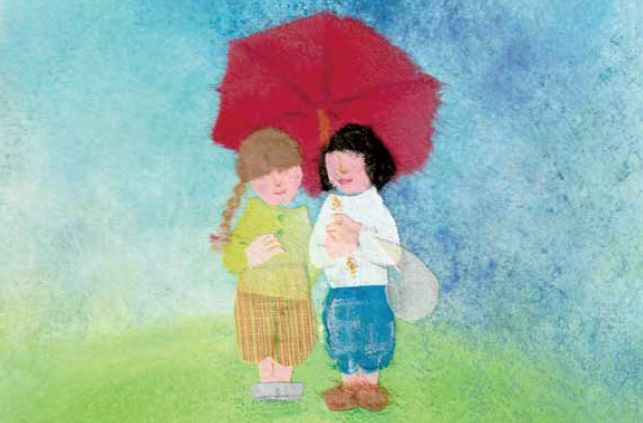2024/11/25
Nagasaki, Atomic-Bomb Sufferers’ Lawsuit: Time is Running Out--- Complete Redress and Passing on the Memory are Essential

Illustration by Izumi Momose (from the picture book The Red Parasol)
On September 24, the prefectural and city governments of Nagasaki appealed a ruling by the Nagasaki District Court, which recognized some sufferers of the wartime atomic bombing—who experienced the blast outside the government-designated relief zone—as Hibakusha, or atomic-bomb survivors.
The District Court ruling recognized 15 of the 44 plaintiffs as Hibakusha, confirming that they had absorbed radioactive ‘black rain’ despite being outside the areas designated by the Atomic Bomb Survivors Relief Law. However, the ruling rejected the claims of the remaining 29 plaintiffs.
In response to the court decision, the central government announced plans to establish a new system to provide medical aid equivalent to that offered to the certified atomic-bomb survivors, aimed at addressing the needs of remaining sufferers whose claims were rejected. However, the government simultaneously expressed its clear intent to appeal the ruling, arguing that it contradicted related legal precedents. Although the Nagasaki prefectural and city governments initially indicated they would accept the judicial decision, they ultimately aligned with the central government's standpoint. Meanwhile, the plaintiffs are also planning to appeal, claiming that it is irrational discrimination to differentiate atomic-bomb survivors based on zoning criteria.
The word “discrimination,” as spoken by the plaintiffs, carries significant weight. The harsh realities faced by Hiroshima atomic-bomb survivors were documented in In This Corner of the World (edited by Tomoe Yamashiro, published in July 1965 by Iwanami Shoten), a collection of reports detailing the experiences of the survivors still struggling with discrimination and the aftereffects of the bombing 20 years after the war. Tragically, their suffering appears to persist even today, 79 years after the bombing. Time is running out for the plaintiffs. I sincerely hope that a political decision to relief survivors will be made, as indicated by former Prime Minister Fumio Kishida—who represents a constituency in Hiroshima—following the annual memorial ceremony.
Recognizing that we have limited time to share with atomic-bomb survivors, various citizen-led activities have emerged to pass on the memories of the atomic bombing to future generations and people worldwide. One such grassroots activist is Midori Mizukoshi, the author’s wife, who hails from Hiroshima. She translated the booklet ‘HIROSHIMA’ into English with her colleagues and published it in 2020. ‘HIROSHIMA’ is a memoir written by Akiko Mizue, who was exposed to the atomic bombing at the age of 7, along with her older sister, Hiroko Takanashi. In addition, Midori Mizukoshi created an English narration video in 2023, with students from her alma mater, Notre Dame Seishin Junior and Senior High School, and students from Hiroshima Jogakuin High School. These students performed the voice-over narration. While working on making the book available in multiple languages, she and her working group published a picture book, Akai Higasa (The Red Parasol), a story based on the atomic bomb experience, this past summer, in collaboration with copperplate engraver Izumi Momose. Recently, another new project with Ms. Momose has also begun. Your support in watching the narration videos (in Japanese and English) and helping to pass on the memory is much appreciated. The picture book is also available from the website below."
※Team Akiko Website:https://team-akiko.jp/
※To request the picture book, please click here::https://team-akiko.jp/red_parasol_form/
This Week’s Focus, 9.22 – 9.26
Takashi Mizukoshi, the President